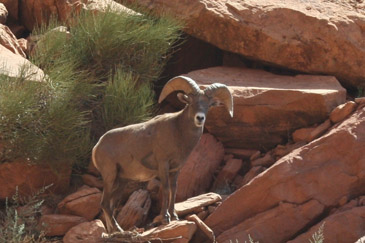Lessons from the Hike to False Kiva
My wife Allison and I got back from a vacation in Moab, Utah a few weeks ago â yes, contrary to popular belief Fred Becker does let me take a day off now and again â and I wanted to share a unique experience we had in Canyonlands National Park, which is is spectacular. Youâve seen some of the more popular vistas on TV and in movies, from Thelma and Louise to Indiana Jones, but there are many others that are equally amazing and will make your jaw drop. On our first night we went into Moab for dinner, wandered into Tom Tillâs photo gallery, and saw an amazing picture entitled âRuin in a Caveâ. The description said it was from a hike to âFalse Kivaâ in Canyonlands, and was one of the most distinctive pictures we had ever seen. We decided then and there to add that hike to our must-do list.
A bit of online research yielded some background information -- kivas are chambers, built wholly or partly underground, used by the Pueblo and Hopi people for religious rites. Many kivas are circular rooms which are often sunken into the ground, bearing a thatch roof with a central opening and ladder for entry. The ruin at False Kiva is just a low circular wall, so it is not known whether this was a true kiva or not, hence the name.  Nobody knows exactly when it was built, but the best guess dates it back to the 1200âs.
We were hooked â but the hike is not in any guidebook, not on any map, nor are there any signs marking the start of the trail â it is, for all intents and purposes, a secret. False Kiva is a Class II archaeological site, which means it is active and unprotected, and the Park Service wants to minimize disruption and traffic. But they are required to tell you how to get there if you ask at the Ranger Station.
Armed with plenty of water we entered Canyonlands the next day, where a friendly Ranger showed us approximately where the trail was on a map, with the decidedly unhelpful advice to âpark in the lot, walk back a couple of hundred yards or so, I think, and look for the obvious trail.â Finding the parking lot was easy, finding the trail was more of a challenge.
We ended up following a wash right to the edge of the mesa, where we could see about the same view as in the picture â as best we could tell, False Kiva was a couple of hundred feet directly below us â but saw no trail down. After wandering along the side of the mesa for a while, we eventually saw the trail from atop a sheer bluff, but had to backtrack quite a ways to get on it â finally, 90 minutes after starting the hike we began to follow the trail down the side of the canyon.
[caption id="attachment_543" align="alignright" width="365" caption="The bighorn sheep is named for its large horns. These horns can weigh up to 30 pounds, while the sheep themselves weigh up to 300 pounds. (Wikipedia.org, http://en.wikipedia.org/wiki/Bighorn_sheep). Photo taken by Dave Frankil."] [/caption]
[/caption]
It was sheer and steep, with loose rock requiring concentration to avoid slips and falls â at points, the trail was narrow, a few feet to our right and a couple of thousand foot drop to the canyon floor on the left. As we were picking our way down one of those narrow points, looking intently at the trail, we heard a clacking sound and then felt a whoosh of air. We were so focused on the trail that we had completely missed seeing a Bighorn Sheep ahead of us. He passed â literally â within a foot of us on the trail. Had he been a tad less sure-footed, or perhaps in an ornery mood that morning, Iâm not sure I would be here to write this. Not sure who was more scared, him or us!
We kept following the trail down the side of the cliff, expecting at each turn to see False Kiva but only seeing more trail and more loose scree (but no more Bighorn Sheep!). Then the trail abruptly turned upwards and doubled back on itself, and we finally clambered up another set of boulders and came upon the site. It is simply astounding that anyone ever found this in the first place â you literally cannot see False Kiva until you are about to enter the site from ten yards away.
False Kiva is in an alcove set back into the mesa cliff face with (as you can see in the âRuin in a Caveâ picture) an incredible view of the Green River Canyon and Candlestick Butte in the distance. Protected from even the whisper of the winds, it has a stillness that is impossible to describe. Coupled with the vista set out in front of us, the near-absolute silence added to the already spiritual nature of False Kiva. It reminded me of the feeling you get when youâre up at dawn at a lake in the mountains, before the wind picks up and the water is still like a mirror, and the birds havenât yet woken up.
We stayed for over an hour, just enjoying the view and drinking in the feel of False Kiva, committing it to memory as best we could. I took a ton of pictures, but the angle of the light wasnât right and I didnât have the proper wide-angle lens to get anything close to Tom Tillâs pictures (it couldnât possibly have been my limited photographic skills!). So instead of posting my pictures here, to avoid the embarrassment, Iâd suggest you look  online for photos by professional photographers, of which there are many. Jjust do a search on Google, youâll find some amazing photos â check out this one from a NASA website that shows the Milky Way at night from False Kiva, which is supposed to be unedited.
There are many management analogies that could be drawn from our False Kiva hike (not the least of which is to make sure you know the path youâre going to take before you start walking), but to me the key takeaway is very basic. There is so much noise in our ânormalâ lives (phone, internet, email, to-do lists, TV, movies, radio, bills that are due, errands to be run, repairs to be made, people to see, planes to catch, Board meetings, budgets, etc.) that it is all too easy to get caught up in what we do, and lose sight of why we do it.
While we all derive great satisfaction from our work, what we do in the office everyday should not be an end in and of itself, rather it should be a means to an end. For us, the simplicity, history and grandeur of False Kiva proved a reminder of what ânormalâ really is, or maybe what ânormalâ can and should be. For a moment I even forgot that the NAFCU Services Board briefing books were due my first day back in the office!
Iâll refrain from posting logistical details online to respect the desire of the Park Service to keep traffic to a minimum, but can provide more specific information via email on how to find the trail and other issues. Â So please feel free to contact me if youâre planning a trip to Moab and want more information on the False Kiva hike.
Post written by Dave Frankil, President, NAFCU Services Corp.

